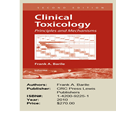 This is a superior textbook for the clinical toxicologist and for undergraduate and beginning graduate students in the clinical sciences including pharmacology and clinical chemistry/clinical toxicology. The textbook covers some of the same topics commonly covered in other toxicology texts (e.g., mechanisms, toxicokinetics, medicinal chemistry), but it stresses certain topics not commonly seen in other toxicology textbooks (e.g., adverse drug reactions, signs and symptoms of toxicity, management of the toxic or overdose case, and the identification of toxicants in human body fluids). The text does not attempt to serve as a reference book for emergency medicine, but it does emphasize human pathology in the presence of human toxicity derived from therapeutic and street drugs, and other toxicants commonly seen in the hospital emergency room. Two chapters not always included in other texts offer information on chemical and biological terrorism and on herbal remedies. There is information on nuclear terrorism included in the chapter on radiation toxicity. A single author text, this book lists 5 additional contributors. It has 441 pages, numerous tables and figures, a table of contents, and an index. References (~10-30) are listed at the end of each chapter and are subdivided into books and journal articles. The book is divided into three parts: This is a superior textbook for the clinical toxicologist and for undergraduate and beginning graduate students in the clinical sciences including pharmacology and clinical chemistry/clinical toxicology. The textbook covers some of the same topics commonly covered in other toxicology texts (e.g., mechanisms, toxicokinetics, medicinal chemistry), but it stresses certain topics not commonly seen in other toxicology textbooks (e.g., adverse drug reactions, signs and symptoms of toxicity, management of the toxic or overdose case, and the identification of toxicants in human body fluids). The text does not attempt to serve as a reference book for emergency medicine, but it does emphasize human pathology in the presence of human toxicity derived from therapeutic and street drugs, and other toxicants commonly seen in the hospital emergency room. Two chapters not always included in other texts offer information on chemical and biological terrorism and on herbal remedies. There is information on nuclear terrorism included in the chapter on radiation toxicity. A single author text, this book lists 5 additional contributors. It has 441 pages, numerous tables and figures, a table of contents, and an index. References (~10-30) are listed at the end of each chapter and are subdivided into books and journal articles. The book is divided into three parts:
- introduction to basic toxicological principles,
- toxicity of therapeutic agents, and
- toxicity of non-therapeutic agents.
Part one has ten chapters including: 1) introduction and description of different areas of toxicology, 2) risk assessment and regulatory toxicology, 3) therapeutic monitoring of adverse drug reactions, 4) classification of toxins in humans, 5) exposure (routes of exposure, etc.), 6) effects (classification of effects and chemical interactions), 7) dose-response, 8) animal toxicity tests, 9) in vitro toxicity tests, and 10) toxic kinetics.
The second part of the book has eleven chapters covering the following classes of therapeutic agents: 1) sedative/hypnotics, 2) opioids and derivatives, 3) sympathomimetics, 4) hallucinogenic agents, 5) anticholinergic and neuroleptic drugs, 6) acetaminophen, salicylates, and nonsteroidal anti-inflammatory drugs, 7) steroids, 8) cardiovascular drugs, 9) antineoplastic drugs, 10) vitamins, and 11) herbal remedies.
The third part consists of 11 chapters on non-therapeutic toxicants including: 1) alcohols and aldehydes, 2) gases, 3) metals, 4) aliphatic and aromatic hydrocarbons, 5) insecticides, 6) herbicides, 7) rodenticides, 8) chemical carcinogenesis and mutagenesis, 9) reproductive and developmental toxicity, 10) radiation toxicity, and 11) chemical and biological threats to public safety.
One very nice feature of this book is the use of a clearly defined chapter outline with numerical as well as verbal headings and subheadings. Each drug listed has both generic/chemical and proprietary names listed. Typical subtopics for each drug include: 1) source and medicinal chemistry, 2) occurrence, 3) chemical structure, 4) pharmacology and clinical use, 5) toxicokinetics, 6) signs and symptoms of acute and chronic toxicity, 7) clinical management of toxicity, 8) tolerance, addiction, and withdrawal.
This book is recommended for a course in clinical toxicology or as suggested reading for a course in pharmacology, clinical chemistry, or forensic toxicology. It is a must have for the clinical toxicology laboratory.
|
